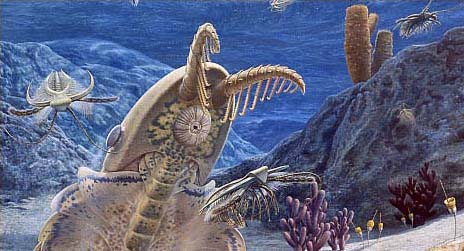 |
 |
 |
 |
 |
Produced
by the Population Genetics and Evolution class, Furman University |
||||
 |
 |
 |
 |
 |
Produced
by the Population Genetics and Evolution class, Furman University |
||||
 |
The
Cambrian: Anomalocaris |
 |
||
| Anomalocaris
canadensis was a superpredator found during the Cambrian period.
They grew to about 60cm, although some specimens have been found that
were over a meter long! It had large appendages near its front that it
used for capturing and grasping prey. Its mouth was located under its
body and was lined with sharp teeth. It had a series of lateral lobes
used for swimming, and large eyes to spot prey. The fossils of Anomalocaris
are one of the most prevalent fossils of the Burgess Shale Formation in
Canada. Specimens have also been found in China, Greenland, and Utah.
The first specimens were found in separate parts that were classified
as different species. The appendages in the front were thought to be crustaceans,
the mouth was thought to be a jellyfish, and the body was thought to be
a sponge (Kazlev 1999). There is still some debate over what phylum Anomalocaris
should be classified under. Many classify it as an arthropod because of
its jointed body. However, the classification of an aschelminth (pseudocoelomate
worm) could be justified because of its asymmetrical mouth (Kazlev 1999).
Many classify it with Opabinia as a "Lobopod", a stem
group of animals that may have given rise to a number of modern phyla,
including the Arthropoda. Anomalocaris canadensis was an important
part of the Cambrian fauna. As an abundant top predator, it might have
put evolutionary pressure on other organisms like trilobites, that evolved
eyes on their dorsal surface (Kazlev 1999). Page by Laura Snyder |
 |
| Anomalocaris. Picture from: Ediacara.org | |
|
Kazlev MA. 2002.Anomalocaris: Cambrian super-predator. www.paleos.com. Accessed Feb 2, 2010. Smithsonian Institution. 2010. Burgess Shale: Anomalocaris canadensis (proto-arthropod). Accessed Feb 2, 2010. |